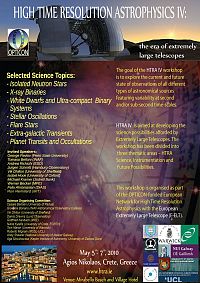›HTRA IV: High Time Resolution Astrophysics in the era of extremely large telescopes
This workshop is organised as part of the OPTICON-funded European Network for High Time Resolution Astrophysics with the European Extremely Large Telescope (E-ELT).
The goal of the HTRA-IV workshop is to explore the current and future state of observations of all different types of astronomical sources featuring variability at the second and/or sub-second time scales. The three day workshop has been planned to offer the community the opportunity to present contributions in different thematic areas covering science, instrumentation and future observing facilities.
Selected science topics include:
- isolated neutron stars
- X-ray binaries
- white dwarfs and ultra compact binary systems
- stellar oscillations
- flare stars
- extra-galactic transients (GRBs)
- planet transits/occultations
although contributions in other science topics related to the field of HTRA are equally welcome.
The focus of the HTRA-IV workshop is on optical studies in all of the above areas. In particular, the major emphasis will be on optical observations and on the potential of HTRA with the next generation of Extremely Large Telescopes (like the E-ELT, the Thirty Meter Telescope and the Giant Magellan Telescope) to make discoveries beyond our current state of knowledge and expectations.
However, the workshop will also focus on HTRA studies at multi-wavelengths (radio, X-rays, gamma-rays) both with present (XMM, CHANDRA, FERMI) and future (e.g. IKO and SKA) observing facilities.
Track this event on your Apple calendar














 Greece
Greece